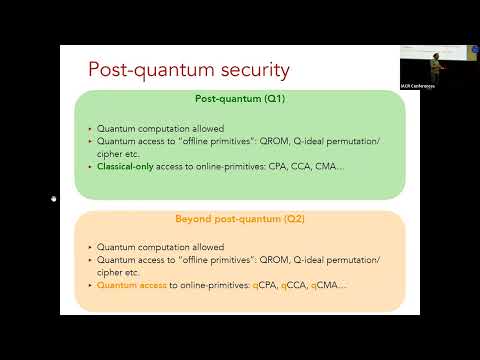CryptoDB
Post-Quantum Security of the Even-Mansour Cipher
| Authors: |
|
|---|---|
| Download: | |
| Presentation: | Slides |
| Conference: | EUROCRYPT 2022 |
| Abstract: | The Even-Mansour cipher is a simple method for constructing a (keyed) pseudorandom permutation $E$ from a public random permutation~$P:\bool^n \rightarrow \bool^n$. It is a core ingredient in a wide array of symmetric-key constructions, including several lightweight cryptosystems presently under consideration for standardization by NIST. It is secure against classical attacks, with optimal attacks requiring $q_E$ queries to $E$ and $q_P$ queries to $P$ such that $q_P \cdot q_E \approx 2^n$. If the attacker is given \emph{quantum} access to both $E$ and $P$, however, the cipher is completely insecure, with attacks using $q_P = q_E = O(n)$ queries known. In any plausible real-world setting, however, a quantum attacker would have only \emph{classical} access to the keyed permutation $E$ implemented by honest parties, while retaining quantum access to $P$. Attacks in this setting with $q_P^2 \cdot q_E \approx 2^n$ are known, showing that security degrades as compared to the purely classical case, but leaving open the question as to whether the Even-Mansour cipher can still be proven secure in this natural ``post-quantum'' setting. We resolve this open question, showing that any attack in this post-quantum setting requires $q^2_P \cdot q_E + q_P \cdot q_E^2 \approx 2^n$. Our results apply to both the two-key and single-key variants of Even-Mansour. Along the way, we establish several generalizations of results from prior work on quantum-query lower bounds that may be of independent interest. |
Video from EUROCRYPT 2022
BibTeX
@inproceedings{eurocrypt-2022-31895,
title={Post-Quantum Security of the Even-Mansour Cipher},
publisher={Springer-Verlag},
author={Gorjan Alagic and Chen Bai and Jonathan Katz and Christian Majenz},
year=2022
}

